Skip the Turkey This Year With These Alternative Thanksgiving Meals
With food prices at record highs, you might be wondering how to save money at your Thanksgiving dinner. While turkey prices have come down a little since last year, and some grocery stores will continue to have turkey giveaway specials as a perk for shopping at their stores, the reality is that the meat isn’t really free, it comes with a big foodprint: a huge cost to the animals, the environment and the people who produce it.
Industrially produced turkeys are raised in barns where they are cramped wall-to-wall, bred to grow massively large, fed on high-corn diets, all of which can lead to major animal welfare concerns and environmental pollution from the birds’ waste, among other issues. However, there are other options. Whether you are cooking for a smaller group, or looking for a more sustainable dinner plan, there are plenty of alternative Thanksgiving meals to make beyond that turkey dinner.
When buying meat — whether it’s smoked ham hocks for flavoring green beans, a Cornish game hen to substitute in for your roast bird, or a heritage turkey — the first step, when possible, should always be to look for pasture-raised, responsibly-produced meat. With that in mind, here are some alternative Thanksgiving meals to the classic turkey dinner.
Use meat as a seasoning for the main vegetable
One way to cut down on your Thanksgiving meal’s foodprint is to cut down on the amount of meat you serve. While we have a tendency to make meat or fish the main course, you can think of it as a seasoning element instead — something to enrich and heighten the flavors of your dish, rather than be the main focus. Cut the amount of meat you use in half in your meatballs or meatloaf by adding in vegetables like chopped mushrooms; or you can use small amounts of smoked meats or fish to add rich flavor to dishes like green bean casserole or collard greens. Some ways to try using meat as a flavoring agent at the holiday table: serve beef and eggplant sauce with pasta or in lasagna; make a soup flavored with smoked ham hocks; or prepare a side dish cooked with smoked turkey legs or smoked whitefish.
Look to bivalves and fish instead
There is no denying that meat — beef, pork, chicken — has a big foodprint. For a smaller impact, think smaller. Bivalves are some of the most sustainable proteins we can eat, in part because bivalve aquaculture can benefit the surrounding environment. Shellfish like mussels, clams and oysters remove carbon dioxide from the ocean as they form their shells, reducing greenhouse gases, and filtering water as they feed on phytoplankton, improving water quality by reducing the amount of toxins and excess nutrients in coastal waters. Along with shellfish, you can also look at smaller fish varieties such as sardines, mackerel and herring, which are more sustainable options than big fish like salmon and tuna.
Using shellfish or smaller fish is also a great alternative thanksgiving meal if you are cooking for a smaller number of people. Serve them as a starter, with dishes like Oysters Rockefeller or clam canapes, or as a main course with a pot of steamed mussels, a big bowl of linguine with clam sauce, or oyster stew with biscuits. And even if you are entertaining for a larger group, dishes like a Southern-style oysters casserole, a squash and seafood chowder, or a creamed oyster stuffing can be festive and also crowd-pleasing.
Think smaller poultry
The chicken industry is no better than the turkey — it has driven farmers into bankruptcy, caused injury to poultry plant workers, bred birds to grow so fast they can’t stand up and polluted the environment with mass quantities of poultry manure. However, producing smaller birds does have a smaller foodprint. Instead of purchasing an industrially produced turkey or chicken, instead look for pasture-raised Cornish game hens, which are typically half the size of typical grocery store chickens, or the much smaller quail, which are usually about a quarter the size of Cornish game hens. There are also options for responsibly produced chicken, if you prefer a larger bird.
Because of their similar anatomy, you can also prepare the hen or quail in the same way you traditionally make your turkey, reducing cooking time, of course. Need some inspiration? For festive flavor, try using a pomegranate molasses marinade, a cranberry stuffing, or roast the game hen with chestnuts. Quail can be marinated in buttermilk and spices, stuffed, or even deep-fried.
Don’t forget duck
While duck is much smaller than the enormous industrially produced turkeys you’ll find in supermarkets, it is usually a few pounds heavier than a roasting chicken, making it a good choice for an alternative Thanksgiving meal. Conventionally-produced ducks suffer many of the same issues as chicken, so as with any poultry, when shopping for duck, look for pasture-raised, antibiotic and GMO-free birds. When it comes to cooking, keep in mind that the method for duck, which has a thick layer of fatty skin, is slightly different than for other poultry. When done right, duck has a beautiful crackling crust and rich, tender meat. Try a honey roasted duck served with pomegranates, roast duck with orange-ginger sauce or, for a larger group, a combo of both duck and pheasant, served with red currant jelly. Or if roasting a whole duck is too much, serve duck breast with cranberry-orange sauce.
Try some game meats
While some alternative Thanksgiving meals are more sustainable due to their diminutive size, there are also some protein options that are simply more sustainable to produce. When raised responsibly, rabbit is produced in a highly efficient manner and has a light environmental foodprint; for the same amount of food and water it takes to produce a pound of beef, six pounds of rabbit meat can be produced. Although most supermarket rabbit is sold frozen, you can look to your local butcher or farmers’ market to find fresh options. Some rabbit recipes with classic Thanksgiving flavors include a maple braised rabbit, a rosemary-wine infused rabbit, and a Southern-style rabbit and cornbread dressing.
Other game options which are more sustainable to produce than industrial poultry include venison and goat. A spice-rubbed goat leg served with pomegranate seeds or a venison mincemeat pie would make an excellent alternative to the turkey dinner.
Skip the main meat entirely
Whether your family is vegetarian, or you just want to cook healthier meals for the holidays, it’s easier to make a Thanksgiving feast without the beast. For smaller groups, a festive pasta dish is a great way to go; the flavors of pumpkin, mushrooms, sage and thyme are so seasonal and wonderful in pasta dishes. Try this savory pumpkin ravioli, sweet potato gnocchi with apple cider sauce, or a Thanksgiving-themed lasagna.
For larger groups, or if you want more of the traditional Thanksgiving leftovers, there are plenty of vegetarian options that are just as stunning as a classic roast turkey. A whole roasted cauliflower looks beautiful and is quite easy; mushroom Wellington might fool family into thinking you’ve made beef; and a vegetable-packed Shepherd’s pie can serve a large number, or make lots of leftovers.
Serve turkey, but buy a heritage breed
If you still really want turkey, there are more sustainable options available than those birds you see for free in the grocery store. Look for heritage breeds, which are a healthier, more flavorful product that you will likely buy directly from the farmer. If you are lucky enough to live near a farmers’ market or local butcher, that’s a good place to start looking. While these turkeys are more pricey than traditional, industrially produced birds, they are produced in a way that’s better for the environment, the animals, the people who work with the animals and the flavor and healthfulness of the final product. Read our guide to shopping for heritage turkeys for more information.
Top photo by Victority/ Adobe Stock.
More Reading
What do faster line speeds in slaughterhouses mean for animals, workers and food safety?
May 8, 2025
When "Made in America" isn't really: Country-of-origin labeling for beef
May 8, 2025
This vegan tiramisu will bring you joy
March 11, 2025
Finding a pet food that aligns with your values
February 11, 2025
The environmental benefits — and limitations — of hunting as a food source
January 6, 2025
The USDA updated label guidelines to increase transparency — is it enough?
September 12, 2024
How can ecofeminism help us envision the future of food?
July 18, 2024
Switching from beef to chicken isn't the sustainability flex you think it is
June 12, 2024
Is it too cruel to eat veal, foie gras and octopus?
May 14, 2024
Nearly a year after USDA approval, lab meat is still off the menu
April 10, 2024


